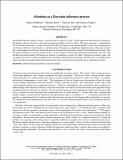Attention as a Bayesian inference process
Author(s)
Chikkerur, Sharat; Tan, Cheston; Poggio, Tomaso A.; Serre, Thomas R.
DownloadPoggio-Attention as a Bayesian inference process.pdf (4.334Mb)
PUBLISHER_POLICY
Publisher Policy
Article is made available in accordance with the publisher's policy and may be subject to US copyright law. Please refer to the publisher's site for terms of use.
Terms of use
Metadata
Show full item recordAbstract
David Marr famously defined vision as "knowing what is where by seeing". In the framework described here, attention is the inference process that solves the visual recognition problem of what is where. The theory proposes a computational role for attention and leads to a model that performs well in recognition tasks and that predicts some of the main properties of attention at the level of psychophysics and physiology. We propose an algorithmic implementation a Bayesian network that can be mapped into the basic functional anatomy of attention involving the ventral stream and the dorsal stream. This description integrates bottom-up, feature-based as well as spatial (context based) attentional mechanisms. We show that the Bayesian model predicts well human eye fixations (considered as a proxy for shifts of attention) in natural scenes, and can improve accuracy in object recognition tasks involving cluttered real world images. In both cases, we found that the proposed model can predict human performance better than existing bottom-up and top-down computational models.
Date issued
2011-03Department
Massachusetts Institute of Technology. Department of Brain and Cognitive SciencesJournal
Proceedings of SPIE--the International Society for Optical Engineering; v.7865
Publisher
SPIE - International Society for Optical Engineering
Citation
Chikkerur, Sharat et al. “Attention as a Bayesian Inference Process.” 2011. Proc. SPIE 7865, 786511–786511–10. Web. 11 Apr. 2012. © 2011 SPIE - International Society for Optical Engineering
Version: Final published version
ISSN
0277-786X